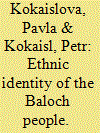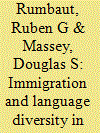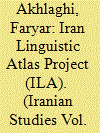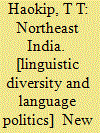|
|
|
Sort Order |
|
|
|
Items / Page
|
|
|
|
|
|
|
| Srl | Item |
| 1 |
ID:
118742


|
|
|
|
|
| Publication |
2012.
|
| Summary/Abstract |
The national self-awareness of the Balochis, who live in several countries and have no statehood, is very specific in many ways. The problem of their identity can be better understood in the context of certain parallels between them and European peoples (ethnic groups), since their ethnogenesis displays certain common features. We should bear in mind, however, that the formation and development of the Balochis differed in many respects from those of the European peoples.
The Balochis of Iran, Afghanistan, Pakistan, and Turkmenistan are not absolutely identical, in this respect they differ greatly from the Europeans.
|
|
|
|
|
|
|
|
|
|
|
|
|
|
|
|
| 2 |
ID:
125148


|
|
|
|
|
| Publication |
2013.
|
| Summary/Abstract |
While the United States historically has been a polyglot nation characterized by great linguistic diversity, it has also been a zone of language extinction in which immigrant tongues fade and are replaced by monolingual English within a few generations. In 1910, 10 million people reported a mother tongue other than English, notably German, Italian, Yiddish, and Polish. The subsequent end of mass immigration from Europe led to a waning of language diversity and the most linguistically homogenous era in American history. But the revival of immigration after 1970 propelled the United States back toward its historical norm. By 2010, 60 million people (a fifth of the population) spoke a non-English language, especially Spanish. In this essay, we assess the effect of new waves of immigration on language diversity in the United States, map its evolution demographically and geographically, and consider what linguistic patterns are likely to persist and prevail in the twenty-first century.
|
|
|
|
|
|
|
|
|
|
|
|
|
|
|
|
| 3 |
ID:
179402


|
|
|
|
|
| Summary/Abstract |
Iran Linguistic Atlas (ILA), funded by the Research Institute for Cultural Heritage and Tourism (RICHT), is a research project for mapping the linguistic diversity of Iran. The project is aimed at recording unified and comparable data from every spoken dialect of Iran’s rural areas and producing self-organized colored maps of this diversity using a specialized software program. Its initial phase began around the mid-1970s in the form of a joint project by the then Iranian Academy of Language and the National Geography Organization. In 2001, the documented data was handed over to the Cultural Heritage Organization, to be saved and expanded. The Iran Linguistic Atlas has now been redefined as an automatic linguistic atlas with the capability of producing self-organizing colored maps according to the operator’s choices. In this article, the ILA, its background and the state of its current phase is introduced. The nature of its data, its earlier and recent field methods, its audiotapes, digital databases and computer databases of phonetic transcriptions are described. In addition, ILA software program is presented and its capability for creating automatic colored maps is discussed thoroughly.
|
|
|
|
|
|
|
|
|
|
|
|
|
|
|
|
| 4 |
ID:
106041


|
|
|
|
|
| Publication |
2011.
|
| Summary/Abstract |
This article revisits the notion of linguistic diversity and its function as a political cleavage. It argues that people's linguistic and cultural attitudes are influenced not only by their communicative practice but also by their identification with particular language(s) - even though they may not always communicate in that language. In Ukraine, from which my empirical data is drawn, language identity is embodied in the concept of native language that was imposed by the Soviet institutionalisation of ethnicity and came to mean ethnic belonging as much as linguistic practice. My analysis of survey data demonstrates that native language is a powerful predictor of people's attitudes and policy preferences with regard to both language use and other socially divisive issues, such as foreign policy and historical memory. This finding should also be applicable to other societies with a large-scale discrepancy between language practice and identity.
|
|
|
|
|
|
|
|
|
|
|
|
|
|
|
|
| 5 |
ID:
092110


|
|
|
|
|
| Publication |
New Delhi, IDSA, 2009.
|
| Description |
24p.
|
| Series |
IDSA occasional paper no. 5
|
| Standard Number |
9798186019633
|
|
|
|
|
|
|
|
|
|
|
|
Copies: C:2/I:0,R:0,Q:0
Circulation
| Accession# | Call# | Current Location | Status | Policy | Location |
| 054563 | 305.809541/HAO 054563 | Main | On Shelf | General | |
| 054564 | 305.809541/HAO 054564 | Main | On Shelf | General | |
|
|
|
|
|
|
|
|
|